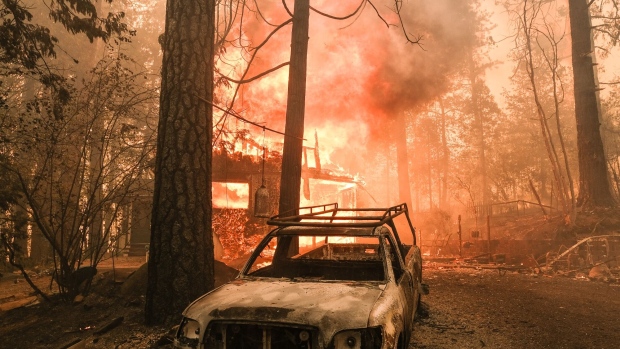Jun 12, 2023
California Wildfires Are Five Times Bigger Than They Used to Be
, Bloomberg News

(Bloomberg) -- The extent of area burned in California’s summer wildfires increased about fivefold from 1971 to 2021, and climate change was a major reason why, according to a new analysis. Scientists estimate the area burned in an average summer may jump as much as 50% by 2050.
Days after wildfire smoke from Canada turned skies orange along the US Eastern Seaboard, the study is further confirmation of past research showing that higher temperatures and drier conditions in many parts of the world make wildfires more likely. Wildfires worsened by greenhouse gases emitted by human activities tore through Australia in 2019 and 2020 and Siberia in 2020.
The peer-reviewed research, published Monday in the Proceedings of the National Academy of Sciences, finds that wildfires in California’s northern and central forests scorch the most area when temperatures are high and less area when it’s cooler.
Marco Turco, a climate researcher at the University of Murcia in Spain, and colleagues designed the study to try to identify how much of the increase in the burned area of California fires was due to climate change, and how much to natural variability. They conducted a statistical analysis of temperature and forest-fire data for California summers in the period 1971 to 2021. They then drew on modeling that shows how the last several decades might have evolved without human-caused greenhouse gas emissions.
The result: Burned area grew 172% more than it would have without climate change. Manmade effects began to overwhelm what would be expected without greenhouse gas pollution after 2001, the researchers concluded.
Many published studies have shown the impact of climate change on California forest fires. A key factor cited in them is the dryness of the air, which scientists call “vapor pressure deficit” — the difference between how much moisture is in the air and how much it can potentially hold at a certain temperature. But forest fires are complicated, and other factors figure in, too, including trends in rain, spring snowpack, the frequency of extreme heat and poor forest management that leaves dried or otherwise combustible wood on the ground ready for a spark.
What Turco found was that one of those variables was far and away the most useful explanation of the shift: temperature, or more specifically, the monthly average of daily peak temperature.
“This was quite surprising to me,” Turco said. “I ran a lot of tests in order to be sure that this really simple model works. For me, it was too easy, and too simple to have this strong results.” But ultimately, he said, “the relationship is very strong.”
Glen MacDonald, a climate scientist and distinguished professor at the University of California at Los Angeles who was not part of the study, said it is “another excellent paper that shows the relationship between anthropogenic climate change and drying the climate.” The link “is true in California, but it is true in the western United States in general and [is] increasing fires,” he said.
MacDonald in May led a large review of the current state of wildfire and climate science in California. The devil is in the details, he said, when it comes to understanding the dynamics for any particular fire. Ecosystems vary dramatically, even within a state. Shrub-dominated Southern California requires different management than forests in central and northern parts of the state, which is what the new study looked at.
“We know what’s exacerbating fire risk, but how we handle that is going to differ from location to location,” MacDonald said.
(Updated in the second paragraph with major recent wildfires outside California and after the eighth paragraph with a chart and comments from Glen MacDonald.)
©2023 Bloomberg L.P.


